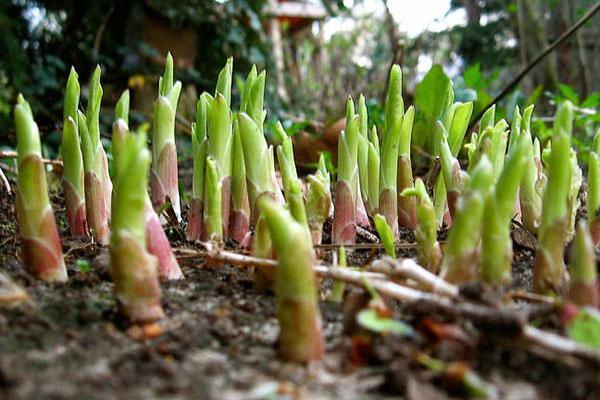Khosta in the spring: sanitary work
 This amazing perennial is planted in shady areas of the garden on slightly acidic soils. But no matter how the host looks in the spring, she should be helped. Then she will thank the owner with an amazing view.
This amazing perennial is planted in shady areas of the garden on slightly acidic soils. But no matter how the host looks in the spring, she should be helped. Then she will thank the owner with an amazing view.
Some gardeners do not cut foliage from the bushes for the winter. It dries up and serves as a covering material for the plant. As soon as the weather returns to normal - rains, frosts and cloudy days will pass - dry leaves are removed from the flower bed. Small sprouts will hatch under them.
Experts recommend cleaning the garden as early as possible while the young shoots are still small. If they actively grow, and "debris" interferes with them from above, then the leaves will undergo deformation.
Read also: landing and caring for the host!
On the agenda: hosta in spring
Often in the fall the plot mulch grass, as well as peat. In this case, it is not at all necessary to make additional feeding. However, over time, it is important to replenish / renew the mulch stock. Moreover, during this period, any varieties of culture suffer from slugs. Being at the embryonic stage, the mollusks tastefully feast on juicy greens. Therefore, there are several ways to deal with them:
- treat the area with chemicals;
- cover the ground with coniferous needles (litter also increases the acidity level in the soil);
- choose varieties with denser leaves that are too tough for pests.
Such prevention of hosts in the spring will help protect the plant as much as possible. Nevertheless, each bush tolerates wintering in different ways. The reason for this is the relief features of the summer cottage, as well as the weather conditions in the area.
Hosta is known for its fleshy bright leaves. Therefore, she is very fond of the nutrient medium. It is nitrogen-containing fertilizers that contribute to the formation of healthy green mass. In other cases, the bed is covered with cut grass, dandelions, or nettles.
Another variant
On some specimens, foliage is not preserved, it is simply blown away by fierce winds. Therefore, the bush germinates much earlier than others. As a result, caring for the plant comes down to the fact that:
- remove all weeds from the garden;
- cover the bare basal necks with peat;
- mulch the soil with spruce needles;
- regularly and abundantly water the site.
For those who dream of propagating hosta, it is worth doing this before the beginning of the growing season - when bluish buds appear. Guessing the weather, of course, is difficult, but possible. Next, the bush is dug out in whole or in part. After which the roots are divided into separate seedlings and transferred to a new place. If they are not watered until the culture gets stronger, then it will not take root well.
Still, it is better to propagate the culture in the fall. Because in spring there is always a threat of unexpected frosts. So, you can water the flower bed, and in the morning it will just freeze.
As you can see, in the spring the hosta does not require any special intervention, except for cleaning from dry leaves and mulching. Coniferous needles are used to acidify the soil, as well as protect against slugs.